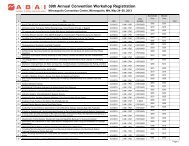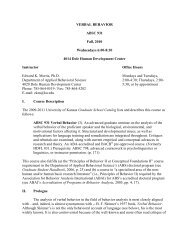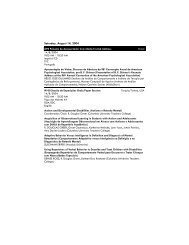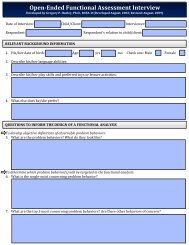psy 668 - Association for Behavior Analysis International
psy 668 - Association for Behavior Analysis International
psy 668 - Association for Behavior Analysis International
Create successful ePaper yourself
Turn your PDF publications into a flip-book with our unique Google optimized e-Paper software.
PSY <strong>668</strong>: ANALYSIS AND TREATMENT OFDEVELOPMENTAL DISABILITIESSpring, 2005 • MW 4:00-5:15pm • 3209 DunbarInstructor: Dr. Jim CarrOffice: 3758 Wood HallPhone: 387-4925E-mail: jim.carr@wmich.eduOffice Hrs: Tue. 3:30-4:30, Wed. 10-11, & by appointmentWeb site: http://homepages.wmich.edu/~carrje/courses.htmlCOURSE GOALSThe purpose of this course is to familiarize you with the contemporary behavior-analytic research on the treatment ofindividuals with developmental disabilities. As most contemporary treatments are based on the results of prior assessments, thecourse will also cover functional assessment and rein<strong>for</strong>cer identification. The course readings are based on contemporarydiscussion and research articles from peer-reviewed journals and edited books. The first two thirds of the course will focus onreducing aberrant behavioral excesses, with the remainder of the course focusing on behavioral acquisition. The readings andclass discussions should provide you with a strong foundation in behavioral treatment (and assessment), with particularemphasis on single-case individualized analyses in well-controlled settings. In addition to the coverage of specific methods, thecourse includes readings on some of the more conceptual and philosophical issues that currently exist in the field.Based on my prior teaching experience, I have determined that success in this course depends at least two things: (a) a solidbehavior-analytic background (general principles and research methods), and (b) carefully reading the course materials be<strong>for</strong>eclass. If you do not have a sound behavioral background and/or are not prepared to commit to the reading requirements, youshould probably reconsider your enrollment in the course.COURSE READINGSYour reading list is comprised of approximately 60 journal articles and book chapters. Two-thirds of the articles are available(in .pdf <strong>for</strong>mat) online at the web site referenced above. The remainder of the readings can be purchased in a coursepack fromthe WMU Bookstore.ATTENDANCE / MAKE-UP POLICYAttendance is not mandatory, but important <strong>for</strong> obtaining in<strong>for</strong>mation from class discussions and taking quizzes and exams.Make-up exams will only be given in cases of documented emergencies, and only if I am in<strong>for</strong>med within 24 hours after thescheduled event.ACADEMIC MISCONDUCTYou are responsible <strong>for</strong> making yourself aware of and understanding the policies and procedures in the Graduate Catalog (pp.26-28) that pertain to Academic Honesty. These policies include cheating, fabrication, falsification and <strong>for</strong>gery, multiplesubmission, plagiarism, complicity and computer misuse. If there is reason to believe you have been involved in academicdishonesty, you will be referred to the Office of Student Conduct. You will be given the opportunity to review the charge(s). Ifyou believe you are not responsible, you will have the opportunity <strong>for</strong> a hearing. You should consult with me if you areuncertain about an issue of academic honesty prior to the submission of an assignment or test.EVALUATION OF STUDENT PERFORMANCEDaily QuizzesAt the beginning of most classes, there will be a 5-minute, multiple-choice/true-false quiz on the assigned readings <strong>for</strong> that day.The purpose of the quiz is to increase attendance, motivate your reading of the material, and minimally evaluate yoursubsequent understanding. Hence, the quizzes will not include questions requiring knowledge of overly specific details.Instead, your knowledge of the main themes and sections of the readings will be assessed. I will drop your lowest quiz scorebe<strong>for</strong>e grade calculation.<strong>Analysis</strong> and Treatment of Developmental Disabilities - 1
In-Class DiscussionI will subjectively assign you up to 3 percentage points toward your final grade based on the quantity and quality of your inclassdiscussion.ExamsThere will be 5 traditional exams this semester, each covering approximately one fifth of the course material. The exams willconsist of short-answer and essay questions. You will have the entire scheduled class time to complete your exam.Discussion ArticleYou will be required to write a brief discussion article of the contemporary research in one area of assessment and/or treatmentin developmental disabilities. The article should summarize the research and important issues relating to a particular topic.You will select a topic from a list presented during the first week of class. The Stromer, McComas, and Rehfeldt (2000)discussion article on delayed rein<strong>for</strong>cement in the 2000 volume of JABA is an excellent model <strong>for</strong> this assignment (except <strong>for</strong>its length). A .pdf version of the article can be found at:http://www.envmed.rochester.edu/wwwvgl/jaba_articles/2000/stromer-33-359.pdfThe manuscript should be double-spaced and written according to APA publication style. You are limited to 10 pages notincluding title page, abstract, and references. The article will be graded as follows: 70% content, 20% writing style, and 10%APA publication style. An outline (with references) of your article is due in class on March 14. The final article is due onApril 11.Re-grade PolicyIf a student disagrees with an evaluation of an exam item or an assignment, a re-grade request may be submitted within oneweek of receipt of the grade in question. The request must contain a full explanation of the point of contention, as well as acopy of the exam or assignment. Re-grade requests will be evaluated only once, and may result in no grade change, or a higheror lower grade being awarded.GRADINGGrade AllocationExams 1-5 . . . . 65%Discussion Article . . . 17%Quizzes . . . . 10%Discussion Article - outline . 5%In-Class Discussion (subjective) . . 3%Grading ScaleA 92-100%BA 88-91%B 82-87%CB 78-81%C 72-77%DC 68-71%D 60-67%E 59% & belowCOURSE SCHEDULEJan. 3Jan. 5Jan. 10Jan. 12Jan. 17Course introduction, syllabus, introductory articleThe “Functional” ApproachFunctional Assessment – In<strong>for</strong>mant AssessmentFunctional Assessment – Descriptive AssessmentNo Class (MLK Day)Jan. 19 Exam 1Jan. 24Functional Assessment – Experimental Functional<strong>Analysis</strong><strong>Analysis</strong> and Treatment of Developmental Disabilities - 2
Jan. 26Jan. 31Feb. 2Feb. 7 Exam 2Feb. 9Feb. 14Feb. 16Feb. 21Feb. 23Feb. 28Mar. 2Mar. 7Functional Assessment – Brief Functional <strong>Analysis</strong>Functional Assessment – EO AssessmentFunctional Assessment – Automatic Rein<strong>for</strong>cementExtinction“Noncontingent” Rein<strong>for</strong>cementEO Modifications & Environmental EnrichmentDifferential Rein<strong>for</strong>cementNo ClassNo Class (Semester Recess)No Class (Semester Recess)Functional Communication TrainingMar. 9 Exam 3Mar. 14 Punishment (outline due)Mar. 16 Punishment (cont’d)Mar. 21 Rein<strong>for</strong>cer Identification - 1Mar. 23 Rein<strong>for</strong>cer Identification - 2Mar. 28 Exam 4Mar. 30Apr. 4Apr. 6Apr. 11Apr. 13Acquisition: Basic TechniquesAcquisition: <strong>Behavior</strong>al Skills Training & ImitationAcquisition: Verbal <strong>Behavior</strong>Acquisition: Misc. (outline due)Toilet Training, Feeding Disorders, Sleep ProblemsApr. 18 Exam 5 (5:00-7:00)Note: I reserve the right to modify this syllabus during the semester.COURSE READINGSIntroductory Reading• Van Houten, R., Axelrod, S., Bailey, J. S., Favell, J. E., Foxx, R. M., Iwata, B. A., & Lovaas, O. I. (1988). The right toeffective behavioral treatment. Journal of Applied <strong>Behavior</strong> <strong>Analysis</strong>, 21, 381-384.The “Functional” Approach• Carr, J. E., Coriaty, S., & Dozier, C. L. (2000). Current issues in the function-based treatment of aberrant behavior inindividuals with developmental disabilities. In J. Austin & J. E. Carr (Eds.), Handbook of applied behavior analysis (pp.91-95). Reno, NV: Context Press.• Iwata, B. A., Vollmer, T. R., & Zarcone, J. R. (1993). The experimental (functional) analysis of behavior disorders:Methodology, applications, and limitations. In A. C. Repp & N. N. Singh (Eds.), Perspectives on the use of nonaversiveand aversive interventions <strong>for</strong> persons with developmental disabilities (pp. 301-330). Sycamore Press: Sycamore, IL.• Feldman, M. A., & Griffiths, D. (1997). Comprehensive assessment of severe behavior problems. In N. N. Singh (Ed.),Prevention and treatment of severe behavior problems: Models and methods in developmental disabilities (pp. 23-29).Pacific Grove, CA: Brooks/Cole.• Optional: Carr, E. G. (1977). The motivation of self-injurious behavior: A review of some hypotheses. PsychologicalBulletin, 84, 800-816.<strong>Analysis</strong> and Treatment of Developmental Disabilities - 3
Functional Assessment – In<strong>for</strong>mant Assessment• O'Neill, R. E., Horner, R. H., Albin, R. W., Sprague, J. R., Story, K., Newton, J. S. (1997). Functional assessment andprogram development <strong>for</strong> problem behaviors: A practical handbook (2nd ed.). Pacific Grove, CA: Brooks/ColePublishing Company. (Chapter 2: pp. 9-25)• Sturmey, P. (1994). Assessing the functions of aberrant behaviors: A review of <strong>psy</strong>chometric instruments. Journal ofAutism and Developmental Disorders, 24, 293-304.Functional Assessment – Descriptive Assessment• Chong, I. M., Carr, J. E., & Sidener, T. M. Descriptive functional assessment of problem behavior: A methodologicalreview. Unpublished manuscript.• Kahng, S., Iwata, B. A., Fischer, S. M., Page, T. J., Treadwell, K. R. H., Williams, D. E., & Smith, R. G. (1998).Temporal distributions of problem behavior based on scatter plot analysis. Journal of Applied <strong>Behavior</strong> <strong>Analysis</strong>, 31, 593-604.• Vollmer, T. R., Borrero, J. C., Wright, C. S., Van Camp, C., & Lalli, J. S. (2001). Identifying possible contingencies duringdescriptive analyses of severe behavior disorders. Journal of Applied <strong>Behavior</strong> <strong>Analysis</strong>, 34, 269-287.Functional Assessment – Experimental Functional <strong>Analysis</strong>• Iwata, B. A., Pace, G. M., Dorsey, M. F., Zarcone, J. R., Vollmer, T. R., Smith, R. G., et al. (1994). The functions of selfinjuriousbehavior: An experimental-epidemiological analysis. Journal of Applied <strong>Behavior</strong> <strong>Analysis</strong>, 27, 215-240.• Hanley, G. P., Iwata, B. A., & McCord, B. E. (2003). Functional analysis of problem behavior: A review. Journal ofApplied <strong>Behavior</strong> <strong>Analysis</strong>, 36, 147-185.• Optional: Carr, J. E., & LeBlanc, L. A. (2003). Functional analysis of problem behavior. In W. O’Donohue, J. E.Fisher, & S. C. Hayes (Eds.), Cognitive behavior therapy: Applying empirically supported techniques in your practice(pp. 167-175). Hoboken, NJ: Wiley.Functional Assessment – Brief Functional <strong>Analysis</strong>• Derby, K. M., Wacker, D. P., Sasso, G., Steege, M., Northup, J., Cigrand, K., & Asmus, J. (1992). Brief functionalassessment techniques to evaluate aberrant behavior in an outpatient setting: A summary of 79 cases. Journal of Applied<strong>Behavior</strong> <strong>Analysis</strong>, 25, 713-721.• Vollmer, T. R., Marcus, B. A., Ringdahl, J. E., & Roane, H. S. (1995). Progressing from brief assessments to extendedexperimental analyses in the evaluation of aberrant behavior. Journal of Applied <strong>Behavior</strong> <strong>Analysis</strong>, 28, 561-576.Functional Assessment – EO Assessment• Smith, R. G., Iwata, B. A., Goh, H., & Shore, B. A. (1995). <strong>Analysis</strong> of establishing operations <strong>for</strong> self-injury maintainedby escape. Journal of Applied <strong>Behavior</strong> <strong>Analysis</strong>, 28, 515-535.• O’Reilly, M. F. (1997). Functional analysis of episodic self-injury correlated with recurrent otitis media. Journal ofApplied <strong>Behavior</strong> <strong>Analysis</strong>, 30, 165-167.• Kennedy, C. H., & Meyer, K. A. (1996). Sleep deprivation, allergy symptoms, and negatively rein<strong>for</strong>ced problem behavior.Journal of Applied <strong>Behavior</strong> <strong>Analysis</strong>, 29, 133-135.Functional Assessment – Automatic Rein<strong>for</strong>cement• Kennedy, C. H., & Souza, G. (1995). Functional analysis and treatment of eye poking. Journal of Applied <strong>Behavior</strong><strong>Analysis</strong>, 28, 27-37.• Piazza, C. C., Hanley, G. P., & Fisher, W. W. (1996). Functional analysis and treatment of cigarette pica. Journal ofApplied <strong>Behavior</strong> <strong>Analysis</strong>, 29, 437-450.• LeBlanc, L. A., Patel, M. R., & Carr, J. E. (2000). Recent advances in the assessment of aberrant behavior maintained byautomatic rein<strong>for</strong>cement in individuals with developmental disabilities. Journal of <strong>Behavior</strong> Therapy and ExperimentalPsychiatry, 31, 137-154.Extinction• Lerman, D. C., & Iwata, B. A. (1996). Developing a technology <strong>for</strong> the use of operant extinction in clinical settings: Anexamination of basic and applied research. Journal of Applied <strong>Behavior</strong> <strong>Analysis</strong>, 29, 345-382.• Iwata, B. A., Pace, G. M., Cowdery, G. E., & Miltenberger, R. G. (1994). What makes extinction work: An analysis ofprocedural <strong>for</strong>m and function. Journal of Applied <strong>Behavior</strong> <strong>Analysis</strong>, 27, 131-144.• Optional: Lerman, D.C., Iwata, B.A., & Wallace, M.D. (1999). Side effects of extinction: Prevalence of bursting andaggression during the treatment of self-injurious behavior. Journal of Applied <strong>Behavior</strong> <strong>Analysis</strong>, 32, 1-8.<strong>Analysis</strong> and Treatment of Developmental Disabilities - 4
“Noncontingent” Rein<strong>for</strong>cement• Carr, J. E., Coriaty, S., Wilder, D. A., Gaunt, B. T., Dozier, C. L., Britton, L. N., Avina, C., & Reed, C. L. (2000). Areview of 'noncontingent 'rein<strong>for</strong>cement as treatment <strong>for</strong> the aberrant behavior of individuals with developmentaldisabilities. Research in Developmental Disabilities, 21, 377-391.• Vollmer, T. R. (1999). Time-based schedules as treatment <strong>for</strong> severe behavior disorders. Mexican Journal of <strong>Behavior</strong><strong>Analysis</strong>, 25, 85-103.• Optional: Vollmer, T. R., & Wright, C. S. (2003). Noncontingent rein<strong>for</strong>cement as treatment <strong>for</strong> problem behavior. InW. O’Donohue, J. E. Fisher, & S. C. Hayes (Eds.), Cognitive behavior therapy: Applying empirically supportedtechniques in your practice (pp. 266-272). Hoboken, NJ: Wiley.EO Modifications & Environmental Enrichment• Wilder, D. A., & Carr, J. E. (1998). Recent advances in the modification of establishing operations to reduce aberrantbehavior. <strong>Behavior</strong>al Interventions, 13, 43-59.• Horner, R. H., Day, H. M., & Day, J. R. (1997). Using neutralizing routines to reduce problem behaviors. Journal ofApplied <strong>Behavior</strong> <strong>Analysis</strong>, 30, 601-614.• Ringdahl, J. E., Vollmer, T. R., Marcus, B. A., & Roane, H. S. (1997). An analogue evaluation of environmentalenrichment: The role of stimulus preference. Journal of Applied <strong>Behavior</strong> <strong>Analysis</strong>, 30, 203-216.Differential Rein<strong>for</strong>cement• Vollmer, T. R., & Iwata, B. A. (1992). Differential rein<strong>for</strong>cement as treatment <strong>for</strong> behavior disorders: Procedural andfunctional variations. Research in Developmental Disabilities, 13, 393-417.• Lindberg, J. S., Iwata, B. A., Kahng, S., & DeLeon, I. G. (1999). DRO contingencies: An analysis of variable-momentaryschedules. Journal of Applied <strong>Behavior</strong> <strong>Analysis</strong>, 32, 123-136.• Tarbox, J., & Hayes, L. J. (2003). Differential rein<strong>for</strong>cement of low-rate behavior. In W. O’Donohue, J. E. Fisher, & S.C. Hayes (Eds.), Cognitive behavior therapy: Applying empirically supported techniques in your practice (pp. 129-135).Hoboken, NJ: Wiley.Functional Communication Training• Hagopian, L. P., Fisher, W. W., Sullivan, M. T., Acquisto, J., & LeBlanc, L. A. (1998). Effectiveness of functionalcommunication training with and without extinction and punishment: A summary of 21 inpatient cases. Journal of Applied<strong>Behavior</strong> <strong>Analysis</strong>, 31, 211-235.• Hanley, G. P., Iwata, B. A., & Thompson, R. H. (2001). Rein<strong>for</strong>cement schedule thinning following treatment withfunctional communication training. Journal of Applied <strong>Behavior</strong> <strong>Analysis</strong>, 34, 17-38.• LeBlanc, L. A., Hagopian, L. H., Maglieri, K. A., & Poling, A. (2002). Decreasing the intensity of rein<strong>for</strong>cement basedinterventions: Conceptual issues and clinical guidelines. The <strong>Behavior</strong> Analyst Today, 3, 289-300.Punishment• Miltenberger, R. H. (2001). <strong>Behavior</strong> modification: Principles and procedures (2nd ed.). Pacific Grove, CA:Brooks/Cole. (Chs. 17-18 – Time-out, Response Cost, Primary Punishment)Punishment (cont’d)• Lerman, D. C., & Vorndran, C. M. (2002). On the status of knowledge <strong>for</strong> using punishment: Implications <strong>for</strong> treatingbehavior disorders. Journal of Applied <strong>Behavior</strong> <strong>Analysis</strong>, 35, 431-464.Rein<strong>for</strong>cer Identification - 1• Pace, G. M., Ivancic, M. T., Edwards, G. L., Iwata, B. A., & Page, T. A. (1985). Assessment of stimulus preference andrein<strong>for</strong>cer value with profoundly retarded individuals. Journal of Applied <strong>Behavior</strong> <strong>Analysis</strong>, 18, 249-255.• Fisher, W., Piazza, C. C., Bowman, L. G., Hagopian, L. P., Owens, J. C., & Slevin, I. (1992). A comparison of twoapproaches <strong>for</strong> identifying rein<strong>for</strong>cers <strong>for</strong> persons with severe and profound disabilities. Journal of Applied <strong>Behavior</strong><strong>Analysis</strong>, 25, 491-498.• DeLeon, I. G., & Iwata, B. A. (1996). Evaluation of a multiple-stimulus presentation <strong>for</strong>mat <strong>for</strong> assessing rein<strong>for</strong>cerpreferences. Journal of Applied <strong>Behavior</strong> <strong>Analysis</strong>, 29, 519-533.Rein<strong>for</strong>cer Identification - 2• Carr, J. E., Nicolson, A. C., & Higbee, T. S. (2000). Evaluation of a brief multiple-stimulus preference assessment in anaturalistic context. Journal of Applied <strong>Behavior</strong> <strong>Analysis</strong>, 33, 353-357.• Bojak, S. L., & Carr, J. E. (1999). On the displacement of leisure items by food during multiple-stimulus preference<strong>Analysis</strong> and Treatment of Developmental Disabilities - 5
assessments. Journal of Applied <strong>Behavior</strong> <strong>Analysis</strong>, 32, 515-518.• Roane, H. S., Vollmer, T. R., Ringdahl, J. E., & Marcus, B. A. (1998). Evaluation of a brief stimulus preferenceassessment. Journal of Applied <strong>Behavior</strong> <strong>Analysis</strong>, 31, 605-620.• Hanley, G. P., Iwata, B. A., & Lindberg, J. S. (1999). <strong>Analysis</strong> of activity preferences as a function of differentialconsequences. Journal of Applied <strong>Behavior</strong> <strong>Analysis</strong>, 32, 419-435.Acquisition: Basic Techniques• Cooper, J. O., Heron, T. E., & Heward, W. L. (1987). Applied behavior analysis. Columbus, OH: Merrill. (Ch. 14 -Shaping)• Cooper, J. O., Heron, T. E., & Heward, W. L. (1987). Applied behavior analysis. Columbus, OH: Merrill. (Ch. 15 -Chaining)• Demchak, M. (1990) Response prompting and fading methods: A review. American Journal on Mental Retardation, 94,603-615.Acquisition: “<strong>Behavior</strong>al Skills Training”• Miltenberger, R. H. (2001). <strong>Behavior</strong> modification: Principles and procedures (2nd ed.). Pacific Grove, CA:Brooks/Cole. (Ch. 12 - <strong>Behavior</strong>al Skills Training Procedures)• Miltenberger, R. G., Roberts, J. A., Ellingson, S., Galenski, T., Rapp, J. T., Long, E. S., & Lumley, V. A. (1999). Trainingand generalization of sexual abuse prevention skills <strong>for</strong> women with mental retardation. Journal of Applied <strong>Behavior</strong><strong>Analysis</strong>, 32, 385-388.Verbal <strong>Behavior</strong>• Sundberg, M. L., & Michael, J. (2001). The benefits of Skinner’s analysis of verbal behavior <strong>for</strong> children with autism.<strong>Behavior</strong> Modification, 25, 698-724.• Miguel, C. F., Carr, J. E., & Michael, J. (2002). The effects of a stimulus-stimulus pairing procedure on the vocalbehavior of children diagnosed with autism. The <strong>Analysis</strong> of Verbal <strong>Behavior</strong>, 18, 3-13.• Sundberg, M. L., Loeb, M., Hale, L., & Eigenheer, P. (2002). Contriving establishing operations to teach mands <strong>for</strong>in<strong>for</strong>mation. The <strong>Analysis</strong> of Verbal <strong>Behavior</strong>, 18, 15-29.Acquisition: Misc.• Dixon, M. R., & Cummings, A. (2001). Self-control in children with autism: Response allocation during delays torein<strong>for</strong>cement. Journal of Applied <strong>Behavior</strong> <strong>Analysis</strong>, 34, 491-495.• Davis, C. A., & Reichle, J. (1996). Variant and invariant high-probability requests: Increasing appropriate behaviors inchildren with emotional-behavioral disorders. Journal of Applied <strong>Behavior</strong> <strong>Analysis</strong>, 29, 471-481.• Shabani, D. B., Katz, R. C., Wilder, D A., Beauchamp, K., Taylor, C. R., & Fischer, K. J. (2002). Increasing socialinitiations in children with autism: Effects of a tactile prompt. Journal of Applied <strong>Behavior</strong> <strong>Analysis</strong>, 35, 79-83.• Lancioni, G. E., O’Reilly, M. F., Campodonico, F., & Mantini, M. (2002). Increasing indices of happiness and positiveengagement in persons with profound multiple disabilities. Journal of Developmental and Physical Disabilities, 14, 231-237.Toilet Training, Feeding Disorders, Sleep Problems• No readingsThe instructor is committed to equal opportunity in education <strong>for</strong> all students, including those with documented physical or learning disabilities. It is theresponsibility of students with documented disabilities to contact the instructor during the first week of class to discuss appropriate accommodations toensure equity in grading, classroom experiences, and outside assignments. If necessary, the instructor will meet with the student and staff members of theDisabled Student Resources and Services office to <strong>for</strong>mulate a written plan <strong>for</strong> appropriate accommodations.<strong>Analysis</strong> and Treatment of Developmental Disabilities - 6












